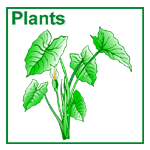| |
Site vegetation and landscape structure essentially determine habitat suitability and potential for wildlife. Classify areas of your site as habitats (e.g. meadow, wetland, woodland, transitional etc.).
When you are Conducting your plant inventory, look for species composition, diversity, height, percent cover, and available and preferred food. In basic terms, this means:
- What Types of plants occur?
- Is one species dominant or are there many species?
- How tall and dense is the vegetation?
- How much of the ground is under vegetative cover?
- Are the plant species food sources for wildlife?
- Are there plant species which are particularly attractive food sources (fruit. seeds, buds, flowers, browse, herbage) ?
Take note of plants as large as trees and as small as lichens. In between these two extremes are forbs, grasses, shrubs,and more. The following identification tips may be helpful:
- Trees and Shrubs: Identify by looking at leaves, flowers, fruits (pine cones, acorns, berries, etc), bark, buds, and shape.
- Wildflowers/Forbs: A wildflower or forb are flowering herbaceous plants that are native to specific regions and able to grow and reproduce in nature without human assistance. Identify by color, size, and structure. Structure includes how flowers are clustered, number of petals or petal-like parts, and shape of flowers and leaves.
- Grasses, Rushes, Sedges: These plants are often difficult to distinguish from each other. A grass is a plant with long, narrow leaves that enwrap a hollow jointed stem. A rush is a grasslike plant with solid round stems. A sedge is a plant with triangular stems and clustered flowerhead, usually found growing in a wetland.
- Ferns: A fern is a leafy delicate plant with divide leaves. Identify by structure, shape, and habitat.
- Mosses, Liverworts, Hornwort: These plants are usually less than an inch tall and often grow in clusters or mats.
- Lichens: Small mosslike plants growing on rocks, trees, soil, and numerous other surfaces. Lichens are remarkably adaptable and are able to live where many other plants cannot. Identify by color, structure, and habitat.
Info-Links:
|
 |

